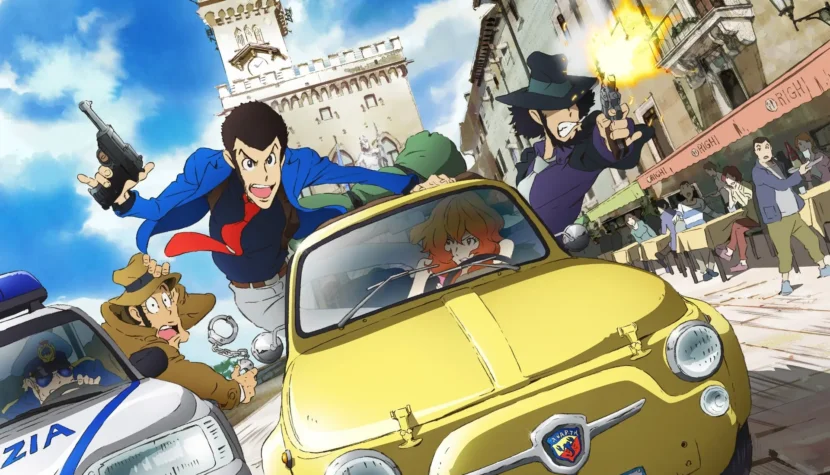LUPIN III: THE CASTLE OF CAGLIOSTRO. Miyazaki’s Feature-Length Debut

I stumbled upon quite a gem—a true classic: the first full-length anime film by Hayao Miyazaki, released in 1979. Before The Castle of Cagliostro, Miyazaki directed two TV series about Lupin—Lupin III and The New Lupin III—as well as the series Future Boy Conan. This full-length Lupin III is the story of the titular hero—a thief—who, together with his companion, sets out to investigate the mysterious castle of the Cagliostro family. It’s worth mentioning that many have ventured into those parts, but none have ever returned… let alone solved the mystery.
That would be a brief summary of The Castle of Cagliostro. However, such a cursory description of one of Miyazaki’s earliest works would be somewhat unfair, so let’s delve deeper into the story. We’ll discuss the characters and their diversity later, but first, everything begins with Lupin and his companion robbing a casino, only to discover that the stolen money is perfect counterfeits—legendary so-called “goat bills.” The protagonists then set off for the titular Cagliostro duchy, the homeland of these mysterious “goat bills.” Danger being their second nature, they quickly decide to uncover the secret, despite the fact that many have tried and failed. Along the way, they encounter a bride being chased by pursuers; Lupin rescues her, and she gives him a mysterious ring. It soon turns out that the ring is coveted by an evil duke who resides in a nearby fortress-like castle. The duke also intends to marry the rescued bride, locking her in a tall tower. Thus, all clues to the mystery lead to the prince’s castle…

It’s important to note that this is far from the only thread in the plot. Even in the early days of his career in anime, Miyazaki favored complex, intriguing storylines, diverse characters, and plenty of action twists—and the latter is certainly abundant here. The plot also involves Interpol, and the mystery of the “goat bills” (counterfeits) fades into the background when it turns out the real prize is a hidden treasure somewhere near the castle, the object of the duke’s obsession. A few flashbacks from Lupin’s life, classic and excellent Japanese humor, surprises, and unexpected plot twists all combine to create this full-length Lupin III movie.
As for the production, it’s evident that this is an older anime—most notably in the simplified drawings and sometimes economical animation. But, folks, this is a 1979 film, so don’t expect the advanced standards of Japanese animation from the last ten or fifteen years. Older anime has its own charm, and for its time, the animation and artwork are quite good, especially the former—vivid, fast-paced, and deliberately comedic in places, which only enhances the final effect. Connoisseurs of Miyazaki’s later works will undoubtedly recognize character designs that influenced his future creations. However, a character as colorful as Lupin is quite unique; I haven’t encountered such a personality in any of Miyazaki’s later films.
Lupin himself is the essence of this movie—a colorful, cheerful, brave, charismatic character. Slightly cocky but always confident. His profession? A thief—an expert one who can get in and out of any situation. He is a descendant of another famous thief of the same name, hence Lupin III. A flirt, sometimes a bit cheeky, talkative, wild, and flamboyant. I’d say he’s probably the most vibrant character in any Miyazaki film. He’s also pursued by an Interpol inspector named Zenigata, who has vowed to arrest Lupin at all costs. Unfortunately for him, despite his good intentions, Zenigata is sometimes rather clumsy.

As for Lupin’s constant companion, Jigen, not much is known, but it’s clear they’ve known each other for a long time and share mutual trust. Jigen is as wild as Lupin and unafraid of danger. There’s also the enigmatic Goemon, a samurai with incredible skills, who aids the duo in uncovering the castle’s secret. The rescued bride, Clarisse, turns out to be a descendant of the Cagliostro family. Then there’s the mysterious Fujiko, an old acquaintance of Lupin, working undercover in the duke’s estate.
On the antagonist side, the lead character is, of course, the duke himself, blinded by his obsession with the hidden treasure. He underestimates Lupin’s skills, a mistake he’ll regret more than once. The entire movie follows the classic battle of good versus evil. While Lupin is a professional thief, he represents good here, fighting against the evil duke. He fights for Clarisse, much like a knight rescuing a princess locked in a tower. This kind of story isn’t groundbreaking, but let’s not forget that such tales were popular a quarter of a century ago. These plots, actions, and themes had their undeniable charm, which persists even today—and likely won’t fade anytime soon. After all, how can the timeless and universal themes of a story, exploited countless times in later years, ever grow old? Even if not always with great success…

The movie is accompanied by pleasant music composed by Yuji Ono. At this point, Joe Hisaishi wasn’t yet Miyazaki’s regular collaborator, though his music appeared in the director’s next anime, Nausicaä of the Valley of the Wind.
The Castle of Cagliostro is a classic tale reimagined in the anime medium. A delightful treat for fans of Miyazaki’s work. While it may not be as brilliant as some other anime I’ve seen, it has a unique charm, and following the fates of the protagonists is an effortless pleasure. An evil duke, a mysterious castle, a princess, a thief and his friends, the eternal battle of good versus evil—these elements never get old, especially when done well. A solid seven out of ten.

